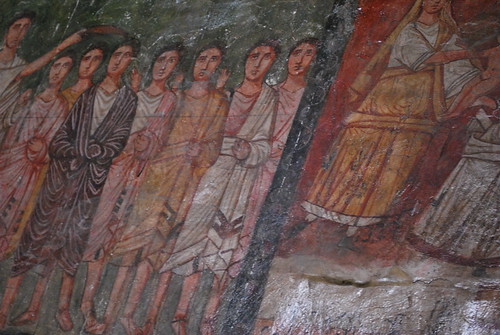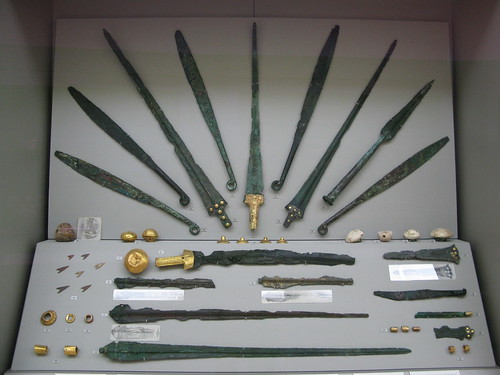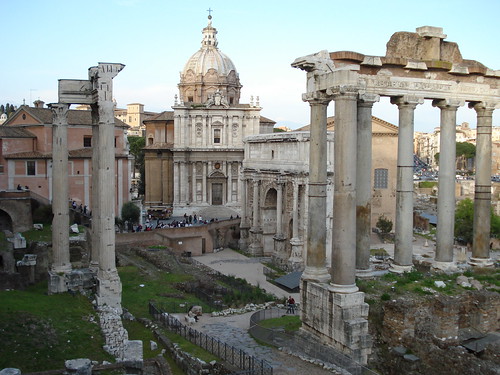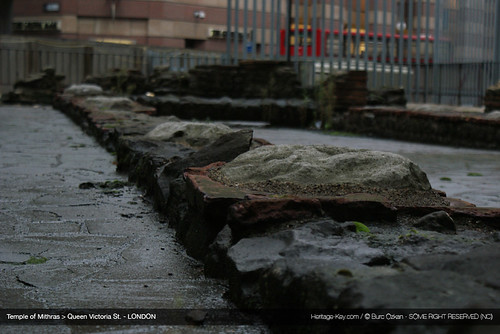 More than 300 looted antiquities, estimated to be worth more than EUR15 million, were displayed to the press this morning in Rome, having been repatriated to Italy after they were discovered in a warehouse in Switzerland.
More than 300 looted antiquities, estimated to be worth more than EUR15 million, were displayed to the press this morning in Rome, having been repatriated to Italy after they were discovered in a warehouse in Switzerland.
It was a scene slightly reminiscent of a Victorian detective novel, in which the robber and his looted candlesticks is unveiled before an impressed gathering of country house guests.
Only today’s unveiling took place inside the Colosseum rather than on the pages of a 19th century novel and while there was no criminal present, there was plenty of loot, which consisted of objects such as Etruscan ceramic vases, bronze statues from Sardinia and frescoes from Pompeii 337 objects in total.
The heat was oppressive for the motley crew of assembled journalists and cameramen who were there to hear the declarations of officials from Italy’s special police force that specialises in tracking down looted antiquities (or to give them their full name, the Carabinieri del Reparto Operativo Tutela Patrimonio Culturale).
The investigation, code-named Andromeda, led by the carabinieri and the Swiss authorities, discovered about 20,000 artefacts in the free port of Geneva, stored in warehouses that were associated with an unnamed Japanese dealer.
The artefacts were illegally taken from archaeological sites in Lazio, Puglia, Sardinia and the area of Magna Grecia southern Italy and Sicily. They span a period of 1,200 years, dating from the eighth century BC to the fourth AD.
According to Dr Giuseppe Proietti, superintendent for archaeological heritage in Rome, this is one of the most important recoveries of looted antiquities in recent times. He said: “This is one of the most significant recoveries of our national heritage to this day. We hope to return these artefacts to their original localities so that they can be displayed within their historical contexts.”
Investigating Looted Artefacts
When the Swiss authorities and the Italian carabinieri began to investigate in 2008, the story developed dramatically in a way that could lead to a sequel of The Medici Conspiracy, a factual book that pieces together the circumstances of the Medici antiquities scandal.
 Their attention was initially drawn to the British art dealer Robin Symes, who curated the sale of the Venus of Morgantina to the Getty Museum in Malib, which will be repatriated to Italy in January 2011. According to the Italian carabinieri, Symes moved to Switzerland, where his activities were monitored and this led the Swiss and Italian team to discover several sham companies, some of which were based in tax havens.
Their attention was initially drawn to the British art dealer Robin Symes, who curated the sale of the Venus of Morgantina to the Getty Museum in Malib, which will be repatriated to Italy in January 2011. According to the Italian carabinieri, Symes moved to Switzerland, where his activities were monitored and this led the Swiss and Italian team to discover several sham companies, some of which were based in tax havens.
Further inquiries led the authorities to a company administrator in Basle who was involved in managing trafficked archaeological objects for his clients one of whom was Mr Symes, say the Italian carabinieri.
When the carabinieri searched the administrator’s luxurious villa in Basle, they found extensive documentation detailing antiquities that were illegally taken from sites around Italy. The documents indicated that Geneva’s free port was used as a clearing centre for the illicitly imported artefacts. In December 2008, nine properties and warehouses were sequestered. This is where the 20,000 archaeological artefacts were discovered.
 It took the authorities the whole of 2009 to catalogue the antiquities. The 337 objects repatriated back to Italy have been proved to be from illicit Italian excavations. The majority of the objects remain under Swiss jurisdiction.
It took the authorities the whole of 2009 to catalogue the antiquities. The 337 objects repatriated back to Italy have been proved to be from illicit Italian excavations. The majority of the objects remain under Swiss jurisdiction.
Many of the antiquities display in the Colosseum are from Puglia. There are important Kylixes, ceramic vases from Etruscan necropolises at Cerveteri and Vulci and Etruscan candelabra. The area of ancient Etruria is one of the areas that has been particularly targeted by looters.
What will happen to these objects now? That hasn’t been decided yet. According to Francesco Maria Giro, the Ministry of Heritage and Culture’s undersecretary, it will take time to scientifically examine the artefacts, but it is hoped that they will be housed in museums near to the sites they were looted from.
Photos by Bija Knowles.


 There are six articles in this issue, but one of the more interesting discussions I found came nearer the back, in the form of a museum review written by Beth Cohen. She discusses the Chimaera of Arezzo, which was on display at the
There are six articles in this issue, but one of the more interesting discussions I found came nearer the back, in the form of a museum review written by Beth Cohen. She discusses the Chimaera of Arezzo, which was on display at the 

 On Tuesday this week public offices in Rome shut down as the city celebrated the feast-day of two of its patron saints, Peter and Paul. So it was an appropriate time for Rome’s archaeological superintendency to announce some of the findings of an archaeological investigation at the
On Tuesday this week public offices in Rome shut down as the city celebrated the feast-day of two of its patron saints, Peter and Paul. So it was an appropriate time for Rome’s archaeological superintendency to announce some of the findings of an archaeological investigation at the 

 Roman ship-discovery season is in full flow, with several finds and explorations announced in the past week.
Roman ship-discovery season is in full flow, with several finds and explorations announced in the past week. 
 It was reported in
It was reported in  O’Neill adds that there is now likely to be a long drawn-out expropriation process while the landowner, the local council and the archaeological authorities thrash out the matter of access and ownership.
O’Neill adds that there is now likely to be a long drawn-out expropriation process while the landowner, the local council and the archaeological authorities thrash out the matter of access and ownership. It was announced at a press conference yesterday in Rome that the oldest known images of the apostles Peter, Andrew and John have been uncovered in one of the city’s Christian catacombs.
It was announced at a press conference yesterday in Rome that the oldest known images of the apostles Peter, Andrew and John have been uncovered in one of the city’s Christian catacombs. The restoration of the frescoes in the tomb was managed by the Vatican’s archaeology office, the Pontificial Commission for Sacred Archaeology, and cost EUR 60,000.
The restoration of the frescoes in the tomb was managed by the Vatican’s archaeology office, the Pontificial Commission for Sacred Archaeology, and cost EUR 60,000. The face of Saint Paul was uncovered last year, recognisable by its pensive eyes, hollow cheeks and pointed dark beard.
The face of Saint Paul was uncovered last year, recognisable by its pensive eyes, hollow cheeks and pointed dark beard.
